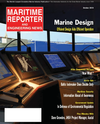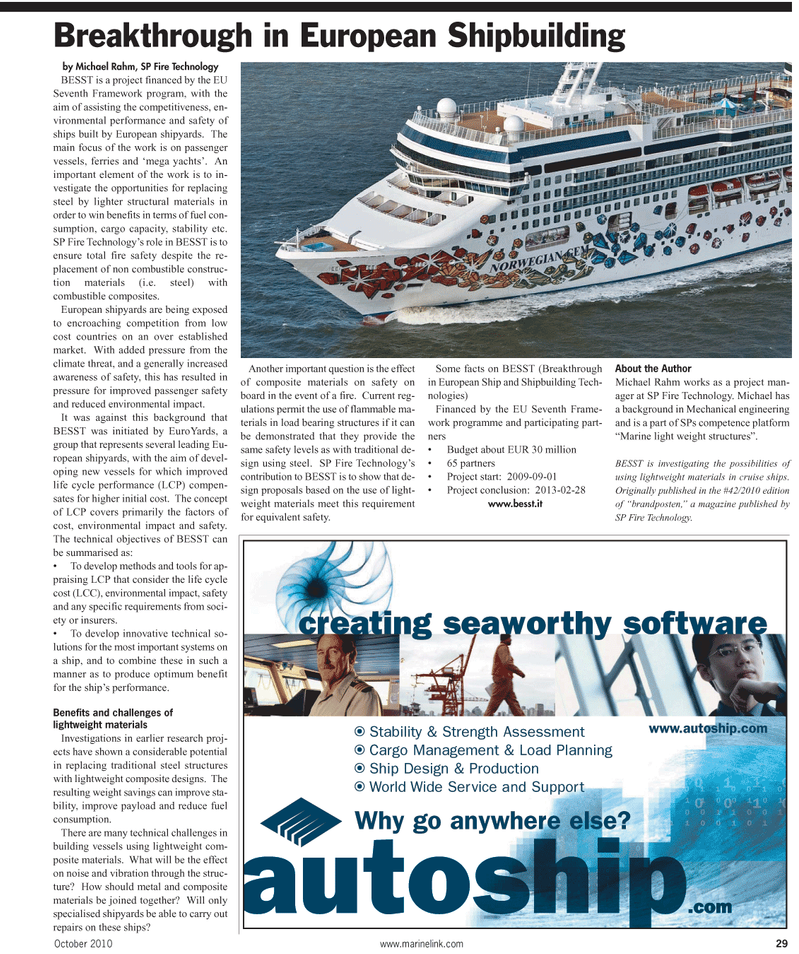
Page 29: of Maritime Reporter Magazine (February 2, 2010)
Read this page in Pdf, Flash or Html5 edition of February 2, 2010 Maritime Reporter Magazine
October 2010 www.marinelink.com 29 by Michael Rahm, SP Fire Technology
BESST is a project financed by the EU
Seventh Framework program, with the aim of assisting the competitiveness, en- vironmental performance and safety of ships built by European shipyards. The main focus of the work is on passenger vessels, ferries and ‘mega yachts’. An important element of the work is to in- vestigate the opportunities for replacing steel by lighter structural materials in order to win benefits in terms of fuel con- sumption, cargo capacity, stability etc.
SP Fire Technology’s role in BESST is to ensure total fire safety despite the re- placement of non combustible construc- tion materials (i.e. steel) with combustible composites.
European shipyards are being exposed to encroaching competition from low cost countries on an over established market. With added pressure from the climate threat, and a generally increased awareness of safety, this has resulted in pressure for improved passenger safety and reduced environmental impact.
It was against this background that
BESST was initiated by EuroYards, a group that represents several leading Eu- ropean shipyards, with the aim of devel- oping new vessels for which improved life cycle performance (LCP) compen- sates for higher initial cost. The concept of LCP covers primarily the factors of cost, environmental impact and safety.
The technical objectives of BESST can be summarised as: • To develop methods and tools for ap- praising LCP that consider the life cycle cost (LCC), environmental impact, safety and any specific requirements from soci- ety or insurers. • To develop innovative technical so- lutions for the most important systems on a ship, and to combine these in such a manner as to produce optimum benefit for the ship’s performance.
Benefits and challenges of lightweight materials
Investigations in earlier research proj- ects have shown a considerable potential in replacing traditional steel structures with lightweight composite designs. The resulting weight savings can improve sta- bility, improve payload and reduce fuel consumption.
There are many technical challenges in building vessels using lightweight com- posite materials. What will be the effect on noise and vibration through the struc- ture? How should metal and composite materials be joined together? Will only specialised shipyards be able to carry out repairs on these ships?
Another important question is the effect of composite materials on safety on board in the event of a fire. Current reg- ulations permit the use of flammable ma- terials in load bearing structures if it can be demonstrated that they provide the same safety levels as with traditional de- sign using steel. SP Fire Technology’s contribution to BESST is to show that de- sign proposals based on the use of light- weight materials meet this requirement for equivalent safety.
Some facts on BESST (Breakthrough in European Ship and Shipbuilding Tech- nologies)
Financed by the EU Seventh Frame- work programme and participating part- ners • Budget about EUR 30 million • 65 partners • Project start: 2009-09-01 • Project conclusion: 2013-02-28 www.besst.it
About the Author
Michael Rahm works as a project man- ager at SP Fire Technology. Michael has a background in Mechanical engineering and is a part of SPs competence platform “Marine light weight structures”.
BESST is investigating the possibilities of using lightweight materials in cruise ships.
Originally published in the #42/2010 edition of “brandposten,” a magazine published by
SP Fire Technology.
Stability & Strength Assessment
Cargo Management & Load Planning
Ship Design & Production
World Wide Service and Support creating seaworthy software www.autoship.com
Why go anywhere else?
Breakthrough in European Shipbuilding

 28
28

 30
30
